The oil and gas (O&G) industry has long grappled with internal corrosion (IC), particularly in deadlegs, which are difficult to monitor and manage. Although extensive data has been collected over the years regarding the causes of failures, pinpointing IC in deadlegs as the cause of failures remains elusive. Efforts to identify, mitigate, and prevent corrosion related failures in deadlegs have gained momentum, particularly with the involvement of the API Data Mining Team (DMT).
API data mining team’s recommendations
Since 2003, the DMT has issued several advisories to improve IC management, especially in deadlegs. Most recently, the PPTS Operator Advisory: Updating Findings on Releases from Facility Piping (2016-1) examines data from 2010 to 2015.[1] This advisory reveals a striking statistic: “Of the facility releases caused by IC, at least 50% occurred at the low point in the pipe…” In its advisory, API recognizes common factors shared by deadlegs, intermittently used facility lines, drain lines, and relief lines—limited or sporadic flow. These characteristics create an environment conducive to IC.
Recommendations for operators
The 2016-1 advisory offers recommendations for operators, including:
- Consider draining and isolating deadlegs, particularly in crude oil service, that serve no further process purpose.
- Develop plans for phasing out deadlegs over time, which aligns with the guidance provided in two other advisories.
- Schedule flushing deadlegs and intermittently used lines. One other advisory highlighted the importance of flushing to manage corrosion risks.
- Develop a program for managing deadlegs, ensuring that these potentially hazardous areas are consistently monitored and maintained.
- Develop a piping inspection program. Three previous advisories emphasized the importance of routine inspections and monitoring to prevent corrosion failures.
Data challenges and inconsistencies
Challenges remain in accurately identifying and reporting corrosion failures, particularly in deadlegs. A review of PHMSA’s Pipeline Failure Investigation reports revealed inconsistencies in categorizing corrosion failures. Of the 113 investigations listed, only a few directly mention deadleg failures, and discrepancies exist in the reported causes. [2] These inconsistencies complicate efforts to track corrosion trends and address the underlying issues effectively. Fifteen incident reports were reviewed; six were attributed to deadleg failures, while two additional incidents involved low points in piping that resembled deadlegs.
Deadleg designation and reporting gaps
A further review of PHMSA incident data between 2010 and 2024 for gas transmission, hazardous liquids, and gas distribution incidents reveals gaps in how deadlegs are reported. In the Gas Transmission Gathering data, a field documents whether a failure occurred in a deadleg. However, this field is only used in a small percentage of incidents: 0.48% for gas transmission and 1.85% for hazardous liquids. Even more troubling, several incidents in a deadleg did not appear in the field, suggesting that the designation is underreported or inconsistently applied.
The Gas Distribution data, covering incidents between 2010 and 2024, did not include any specific designation for deadlegs but did document one incident that was attributed to a deadleg. The lack of a field for deadleg identification in the gas distribution data further complicates efforts to track and manage these risks. Many deadleg failures may not meet the reporting threshold required by PHMSA, thus contributing to the underrepresentation of this issue in official reports.

Addressing the root causes
In response to the challenges in identifying causes of corrosion failure, API has initiated interviews with companies with PHMSA reportable incidents. API aims to uncover the true causes of corrosion-related failures and provide better guidance for operators in the future. To assist with this initiative, a comprehensive survey has been developed to guide discussions and identify key factors contributing to corrosion in deadlegs. This effort is critical in shaping future guidance and developing targeted solutions for the industry.
Terminology dilemma
An often-overlooked issue in the search for better data is the variation in the spelling and terminology used to describe deadlegs. The term “deadleg” has been spelled in numerous ways: as two words, hyphenated, and as a single word. In some cases, it is referred to as “dead ends.” These variations create more challenges when searching for relevant data across multiple databases and documents. Standardizing the term and its spelling would streamline future research and improve reporting accuracy.
Conclusion: Standardization and improved reporting
As the industry continues to refine its understanding of IC in deadlegs, standardizing terminology, improving reporting practices, and enhancing data collection methods are crucial steps in addressing the issue. API’s ongoing efforts to uncover the root causes of corrosion failures through surveys and interviews, combined with the recommendations in its advisories, will help operators better manage this persistent threat. The goal is to reduce failures, improve safety, and ensure the long-term integrity of the O&G infrastructure.
Addressing these challenges, the O&G industry can continue to evolve toward more effective corrosion management practices, aiming to minimize downtime, reduce risks, and ensure safe, efficient operations across the sector.
References
[1] American Petroleum Institute. (n.d.). PPTS advisories. American Petroleum Institute. https://www.api.org/oil-andnatural-gas/wells-to-consumer/transporting-oil-natural-gas/ pipeline-performance-tracking-system/ppts-related-files/ ppts-advisories
[2] U.S. Department of Transportation Pipeline and Hazardous Materials Safety Administration. (n.d.). Pipeline failure investigation reports. PHMSA. https://www.phmsa.dot.gov/safety-reports/ pipeline-failure-investigation-reports
[3] Ward, L. A. (2025). Managing internal corrosion threats in unpiggable pipelines and facility dead legs. Proceedings of the Pipeline Pigging and Integrity Management Conference (PPIM).
This article was written by specialist Leslie Ward and published as part of the fifth edition of Inspenet Brief magazine, August 2025, dedicated to technical content from the energy and industrial sectors.

